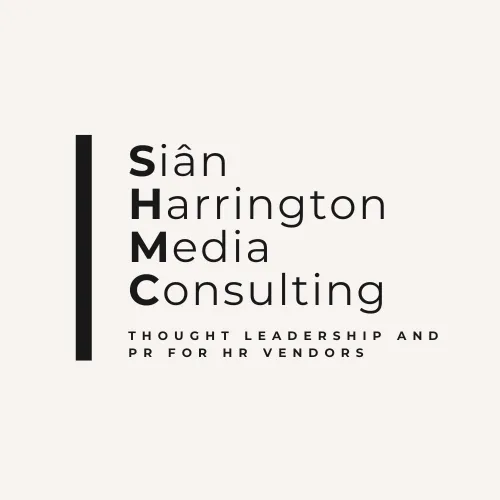Elevate Your HR Tech Brand: Essential PR Strategies

Discover how to elevate your HR tech company's PR strategy with targeted messaging, stakeholder insights and relationship-driven tactics. Learn to build credibility and connect with HR professionals through multi-channel approaches and thought leadership with our roadmap
In the highly competitive HR technology market developing an effective public relations (PR) strategy is crucial for standing out. A well-crafted press release can create initial buzz but relying solely on this tactic is insufficient. To help HR tech companies enhance their marketing efforts Siân Harrington Media Consulting conducted in-depth research with 100 HR directors and chief people officers to uncover what truly resonates with them – and what doesn’t. This research forms the foundation of our insights, offering a roadmap for HR tech companies to build lasting relationships and establish credibility with HR professionals. Here’s how to craft a PR strategy that goes beyond the basics.
1. Knowing your (real) target audience
To succeed with your PR strategy HR tech companies must understand the complexities of their audience. HR professionals are not a monolithic group. They include decision-makers, influencers and gatekeepers, each playing distinct roles in the purchasing process.
Misidentifying these stakeholders can derail your PR efforts. For example, while HR directors are key players they might not hold the final say on budget decisions. In some organisations, the chief financial officer or the chief executive officer may have the ultimate authority. Tailoring your PR messaging to acknowledge these dynamics is crucial. Craft messages that address the specific concerns and interests of HR directors, while also considering the broader decision-making framework within which they operate.
Identifying key stakeholders
Understanding who holds the budget and who influences purchasing decisions is vital. Begin by conducting a detailed stakeholder analysis for each potential client. This should include identifying the decision-makers, influencers and those who may block your progress. By mapping out the decision-making hierarchy you can tailor your PR efforts to engage the right people at the right time.
For instance if your research reveals that HR directors are influential but do not control the budget your PR strategy should include messaging that appeals to both the HR director and the actual budget holder, such as the CFO. This approach ensures that your messaging resonates with all key players, increasing the likelihood of a successful outcome.
Building buyer personas
To further refine your PR strategy develop detailed buyer personas for each of the key roles within your target audience. These personas should include demographic information, pain points, goals and the preferred communication channels of your audience. For example an HR director may prioritise efficiency and compliance, while a CFO may focus on return on investment and cost savings.
By creating these personas you can craft more targeted and effective PR messages that address the specific needs and concerns of each stakeholder. This not only improves engagement but also helps to build trust and credibility with your audience.
2. Moving beyond the feature list
A common mistake in PR strategies is to focus too heavily on product features. HR professionals are inundated with information and are more interested in solutions that address their challenges than in a laundry list of features.
The pitfall of feature-heavy messaging
Focusing solely on features can alienate your audience as it often fails to answer the critical question: "What’s in it for me?" HR professionals want to know how your product will make their jobs easier, more efficient or more effective. Simply listing features without explaining the benefits is unlikely to engage them.
Instead shift the focus from features to benefits. Your PR efforts should highlight how your product solves real-world problems, reduces costs, saves time or simplifies complex processes. For instance, if your HR tech product streamlines the recruitment process don’t just list the technical features – explain how it helps HR teams fill positions faster and more efficiently.
Translating features into benefits
One of the most effective ways to shift from a feature-focused approach to a benefit-driven PR strategy is to translate each feature into a tangible benefit. For example if your HR software includes an automated compliance feature explain how it reduces the risk of legal issues and saves the HR team hours of manual work.
Consider the following example: "Our software automates compliance reporting, ensuring that your organisation stays within regulatory guidelines while freeing up your HR team to focus on strategic initiatives." This message not only highlights the feature but also emphasises the direct benefit to the HR director and their team.
Supporting your claims with evidence
To build credibility back up your claims with data and case studies. Sharing real-world success stories where your product made a tangible difference will resonate more with HR professionals and establish trust in your brand. For example you could present a case study showing how your product helped a client reduce recruitment time by 30% and saved them significant costs in the process.
Incorporating testimonials from satisfied clients further strengthens your PR messages. Our research shows HR professionals are more likely to trust the experiences of their peers than marketing claims, so including quotes or short success stories from existing customers can significantly enhance your credibility.
3. Building a consistent brand presence
A key component of a successful PR strategy is consistent brand presence. HR professionals are more likely to engage with brands they recognise and trust. Unfortunately many HR tech companies underestimate the importance of consistent PR efforts, assuming that a good product alone will suffice.
The importance of brand consistency
In the HR tech market brand recognition and trust are crucial. HR professionals often turn to familiar brands when making purchasing decisions. If your brand is consistently present in the market it is more likely to be top of mind when HR directors are ready to make a decision.
To build a strong brand presence you need to maintain visibility in the market. This involves more than occasional press releases. Participate in industry events, publish thought leadership content and leverage testimonials from satisfied clients. Regularly sharing insights and research positions your brand as a trusted advisor, not just a vendor.
Leveraging thought leadership
Establishing yourself as a thought leader in the HR tech space is an effective way to build a consistent brand presence. Thought leadership content, such as white papers, blog posts and industry reports, can showcase your expertise and provide valuable insights to your audience.
For example you could publish a white paper on emerging trends in HR technology, offering practical advice on how organisations can stay ahead of the curve. By sharing this content through various channels, such as social media, email newsletters and industry publications, you can increase your brand’s visibility and establish yourself as a trusted source of information.
Engaging with industry events
Participating in industry events is another way to build brand recognition and trust. Whether it’s speaking at a conference, hosting a webinar or sponsoring an industry event these activities can help you connect with HR professionals and showcase your expertise.
When participating in events focus on providing value rather than promoting your product. For instance you could present a case study on how your product has helped organisations improve employee engagement followed by a Q&A session where attendees can ask questions and learn more about your solution.
Utilising testimonials and case studies
As mentioned earlier, testimonials and case studies are powerful tools for building trust and credibility. By consistently sharing success stories and client testimonials you can reinforce your brand’s reputation as a reliable and effective solution provider.
Consider creating a dedicated section on your website for case studies and client testimonials as well as media coverage. This not only makes it easy for HR professionals to find and read these success stories but also signals that your brand values transparency and customer satisfaction.
4. Diversifying PR efforts
One of the biggest pitfalls in PR strategy is over-reliance on singular initiatives. Investing all your resources into a single press release or event without follow-up is a recipe for missed opportunities.
The risks of singular PR efforts
Relying on a single PR tactic, such as a press release or a one-off event, can lead to short-lived success. While these activities may generate initial interest they are unlikely to sustain momentum over the long term. HR professionals may be intrigued by your product at first but without consistent follow-up and engagement, their interest may quickly fade.
A robust PR strategy for HR tech companies requires a diversified, multi-channel approach. This means using a mix of blogs, social media, webinars and ongoing media relations to keep your brand in front of your target audience. Different HR professionals consume content in different ways so spreading your PR efforts across multiple platforms increases your chances of reaching them.
Integrating PR into your marketing strategy
PR is most effective when it’s part of a broader, holistic marketing strategy that seamlessly connects all your communication efforts. A multi-channel PR approach should be integrated with other marketing activities to create a cohesive and impactful message across various platforms.
For instance, you might begin with a press release announcing a new product feature, but instead of stopping there, you weave this message into your entire marketing ecosystem. Follow up the press release with a series of blog posts that explore the feature in detail, providing valuable insights for your audience. At the same time, amplify the message through targeted social media campaigns and email newsletters that direct readers to related content.
To deepen engagement, host a webinar or live event that not only demonstrates the new feature but also ties back to the key messages you've shared with the media and across your channels. This interconnected approach ensures that your audience receives a consistent message, whether they’re reading an article, attending a webinar, or following your social media. By creating a unified narrative, you enhance your brand’s visibility and resonance, increasing the likelihood of meaningful engagement and long-term relationships with your audience.
Repurposing content for maximum impact
Another key aspect of a diversified PR strategy is repurposing content. By turning a single piece of content into multiple formats you can extend its reach and maximise its impact. For example a white paper could be repurposed into a series of blog posts, an infographic, a webinar and a podcast episode.
Repurposing content not only saves time and resources but also ensures that your message reaches your audience through their preferred channels. It also allows you to reinforce your brand’s key messages and maintain a consistent presence across multiple platforms.
Tracking and measuring success
To ensure that your diversified PR strategy is effective it’s important to track and measure the success of your efforts. This could involve monitoring website traffic, social media engagement, webinar attendance, and media coverage. By analysing these metrics, you can identify what’s working and what’s not and adjust your strategy accordingly.
Regularly reviewing and refining your PR strategy will help you stay ahead of the competition and ensure that your brand continues to resonate with HR professionals.
5. Relationship-focused PR
Finally, an essential component of your PR strategy should be avoiding overly salesy tactics. HR professionals are bombarded with sales pitches, and aggressive tactics can quickly alienate them.
The pitfalls of being too salesy
HR professionals are constantly bombarded with marketing messages and sales pitches, making them adept at filtering out aggressive or overly promotional tactics. If your PR strategy is too focused on pushing your product, you risk not only alienating your audience but also diminishing your credibility in the eyes of the media and potential customers.
Effective PR should go beyond mere promotion. It should centre on establishing thought leadership and contributing valuable insights that advance industry conversations. By sharing informed opinions, original research, and well-considered analysis, you position your brand as a trusted authority in the HR space. This approach resonates with both HR professionals and journalists, as it provides them with meaningful content that helps to move stories forward rather than just adding to the noise.
Instead of simply trying to sell, your PR efforts should be about offering real value. When you contribute genuinely useful information and thought-provoking perspectives, you build stronger relationships with your audience. Over time, this approach fosters trust and positions your brand as a go-to resource for the media and industry professionals alike, leading to deeper engagement and more meaningful coverage.
Adopting a relationship-driven PR strategy
A relationship-driven PR strategy involves prioritising meaningful interactions over broad outreach. Rather than casting a wide net with generic messages to all media on a database focus on building deeper connections with a more targeted group of influential editors and journalists in the HR media space.
Journalists want exclusives! Every approach should consider the specific requirements of that publication or blog and what it has already written on the subject. As a business and HR journalist of more than three decades I know how annoying - and frankly insulting - it is when it is clear the organisation or PR agency pitching has not read your publication or noted the level of seniority of the audience. This can do more harm than good! If you don't have deep relationships with the right HR media then consider using an agency who does.
Crafting compelling stories and avoiding common PR mistakes
In PR, particularly within the HR tech space, one of the most effective ways to gain traction is by telling compelling stories that resonate with your audience and the media. However, many companies make the mistake of focusing too much on self-promotion rather than what makes a story newsworthy or valuable to the HR community.
HR professionals, and the journalists who cover their industry, are more interested in stories that offer genuine insights, tackle pressing challenges or highlight innovative solutions. Simply pushing out product updates or company achievements without a broader narrative often falls flat. A strong PR strategy should weave in real-world impact, client success stories, and industry trends to create content that adds depth to your narrative and captures media interest.
Another common mistake is overlooking the importance of thought leadership in PR. It’s not enough to just be another vendor in the market. To stand out your PR efforts should aim to position your brand as a thought leader – someone who offers expert opinions, forecasts industry trends or provides unique data and research that others can’t. This approach not only attracts media coverage but also builds credibility with HR professionals who are looking for trusted sources of information.
Networking and referrals also play a crucial role in building a successful PR campaign but they should be approached strategically. Hosting networking events or participating in industry forums is not just about being present; it’s about creating opportunities for meaningful conversations that can evolve into stories worth telling. Engage with HR professionals by focusing on the challenges they face and how your insights or solutions can help, which in turn creates a narrative that is more likely to be picked up by the media.
Ultimately, the key to effective PR in the HR tech space is to ensure that your stories are not just about what you want to say, but about what your audience and the media want to hear. By avoiding the pitfalls of being too salesy or self-focused, and instead concentrating on what makes a compelling and valuable story, you can elevate your PR efforts and build stronger, more influential relationships in the industry.
Conclusion
Crafting a successful PR strategy for HR tech companies involves much more than just issuing press releases. By understanding your audience, focusing on benefits over features, maintaining consistent brand presence, diversifying your efforts and building meaningful relationships through a comprehensive PR campaign you can develop a strategy that not only captures attention but also fosters lasting credibility.
To help you refine your PR and marketing strategy and connect more effectively with HR directors we’ve compiled insights from our research into The HR Vendors Marketing Toolkit, a free 5-day email course. Alongside the course you get access to a free detailed 24-page report that delves deeper into the preferences, challenges and decision-making processes of HR buyers. This report complements the course content, providing a broader context and actionable strategies that help vendors connect more effectively with their target market.

